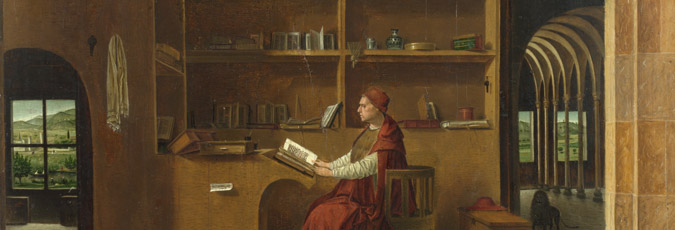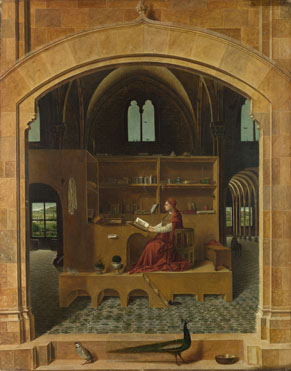Antonello da Messina (active 1456; died 1479)
'Saint Jerome in his Study', about 1475
Oil on lime, 45.7 x 36.2 cm
NG1418
Antonello da Messina's portrayal of Jerome, the most well-known of the four learned Doctors of the Church, is as much a depiction of space as of personality. Indeed it is the particularity of place, the setting for Jerome’s writings – notably his rendering of the Bible into Latin (the Vulgate) – which conveys the moral character of the man. A wide arch opens directly into the private space occupied by Jerome. As is usual in Renaissance paintings, he is dressed in the red robes of a cardinal (an office which did not exist during his lifetime; for a rare exception see Catena's potrayal, to convey his importance in the ecclesiastical hierarchy. Jerome sits at a wooden desk, part of a fully designed and disconcertingly modern work platform, filled with the paraphernalia of life and study. He has left his slippers at the bottom of the steps, underlining the metaphor between entering this secluded space and the privacy which study imparts to the mind. We see him, but he does not see us. As Niccolò Machiavelli expressed it so beautifully in the early 16th century, on entering the study: ‘I strip off my muddy, sweaty, workaday clothes, and … I enter the antique courts of the ancients …. And for the space of four hours I forget the world.’1

The subject of Jerome in his study is not uncommon in 15th- and 16th-century painting. Niccolò Colantonio of Naples, who is recorded by Summonte in 1524 as having been the Sicilian Antonello’s teacher, depicts Jerome seated in a room furnished with a study area of similar complexity (fig. 1). But both Colantonio’s picture (part of a dismembered polyptych made for the Neapolitan church of San Lorenzo Maggiore), and a panel in the Detroit Institute of Arts attributed to Jan van Eyck – or, more likely, a follower – show the study as a claustrophobic space. In these works, and others, the scholar is hemmed in by books and objects, which enclose him as much as they identify him.
The saint's study
Antonello’s picture is remarkable for the complexity of Jerome’s architectural setting. Jerome was believed to have left the corruption of Rome for Bethlehem, where he founded a Latin monastery and a separate women’s convent, and worked on his Latin translation of the Bible. Antonello has imagined Jerome’s book room as a lofty vaulted interior divided into aisles by arcades. A Crucifix is just visible at the top left, Christ’s outstretched arms almost mirroring the spring of the arch behind it. Seated on a rounded chair (a cathedra, or bishop’s seat), the learned saint reads and meditates. His cardinal’s hat is placed on a bench behind, and an array of (mainly open) books sit on the shelves around and even above him. This is also a living space. A towel hangs on a peg at the left, and a sleeping cat and potted plants are placed on the platform floor at Jerome’s feet. And to the left, a door opens off the wooden study, leading through the church-like interior to a large square window, with benches from where to contemplate a verdant landscape stretching away to distant mountains.
As Dora Thornton has demonstrated, studies like this – close in spirit, if not in execution to the modern ‘workstation’ – did exist in the 15th century. They were commonly made of wood and fixed to walls and, as they were fixed structures, they were rarely mentioned in inventories. The most fully described is one recorded in the 1498 inventory of Lorenzo di Pierfrancesco de’ Medici’s possessions, in a house at Fiesole: ‘a large writing desk … with boards and a backrest, and with a cupboard with a cornice made of walnut, and compartments decorated with inlay. Underneath the desk, where one puts one’s feet, is a wooden platform raised up from the ground.’2
The spiritual expressed in the setting
Where Antonello’s study differs from such structures is in the absence of the ceiling and two walls. It is as if we the viewers are entering the study, and by implication have a privileged view of the mind of the learned saint. The spiritual nature of Jerome’s thought is expressed through the architectural character of the setting. Jerome and his study are in the middle of the vault, just as his Vulgate was central to the beliefs and worship of Western Christianity.
The architecture is described with precision, as is the setting which gives visual expression to the idea that Saint Jerome’s scholarship was the intellectual bedrock of the Western Church. The veins of the stone archway are suggested with individual swirls of the painter’s brush, while a myriad of incised lines have been used to lay out the masonry wall behind the saint, and the ceramic tiled floor, which recedes into the distance. At the right, the tame lion, whose paw Jerome had healed, stops and looks towards us, as it walks along a vaulted colonnaded passage. The columns of this arcade are long and thin, like those in the vault which rises over the saint’s study. In the 16th century this painting was in Venice, where the connoisseur Marcantonio Michiel, stunned by its incredible detail, incorrectly described it as the work of the Flemish painter Jan van Eyck, who was famed for paintings of even more meticulous quality. In fact, it was probably painted in Venice.
Davies 1961, pp. 40–1; Dunkerton, Foister, Gordon and Penny 1991, pp. 318–9; Rome 2006, pp.212–4.
This material was published in April 2014 to coincide with the National Gallery exhibition 'Building the Picture: Architecture in Italian Renaissance Painting'.
To cite this essay we suggest using
Caroline Campbell, ‘Antonello da Messina, Saint Jerome in his Study’ published online 2014, in 'Building the Picture: Architecture in Italian Renaissance Painting', The National Gallery, London, http://www.nationalgallery.org.uk/research/research-resources/exhibition-catalogues/building-the-picture/entering-the-picture/antonello-da-messina-saint-jerome


